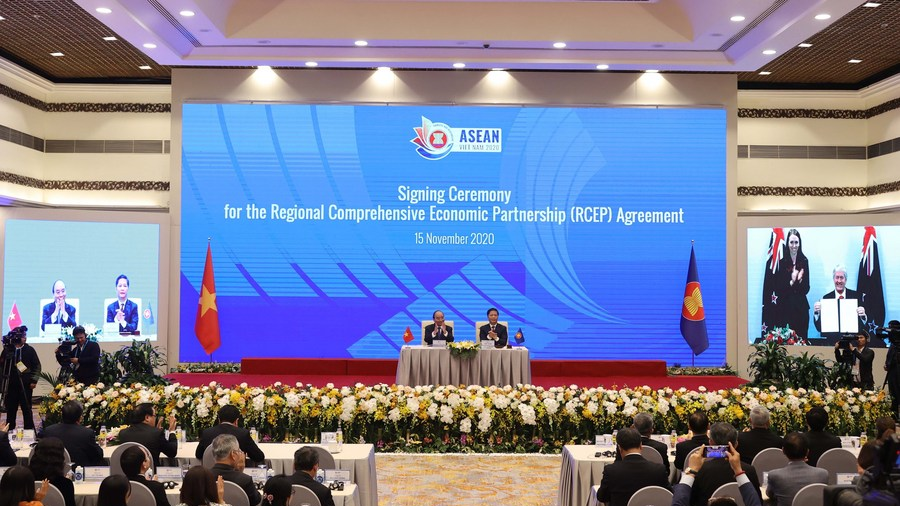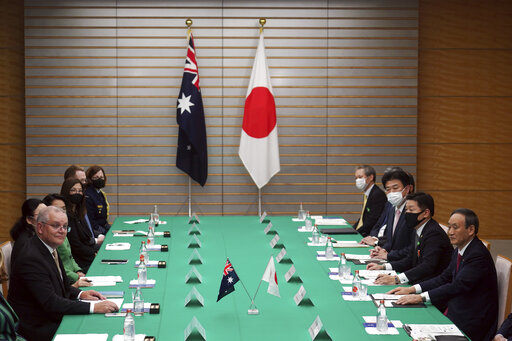
The signing ceremony of the RCEP agreement is held via video conference in Hanoi, Vietnam, November 15, 2020. /Xinhua
The signing ceremony of the RCEP agreement is held via video conference in Hanoi, Vietnam, November 15, 2020. /Xinhua
Editor's note: Daryl Guppy is an international financial technical analysis expert. He has provided weekly Shanghai Index analysis for the Chinese mainland media for more than a decade. Guppy appears regularly on CNBC Asia and is known as "The Chart Man." He is a national board member of the Australia China Business Council. The article reflects the author's opinions, and not necessarily the views of CGTN.
The Regional Comprehensive Economic Partnership (RCEP) gives Australia the opportunity to potentially improve its relationship with China. Australian economist Tim Harcourt believes "the RCEP will settle down our relationship with China, simply because it gets us around the table with them." Others see the RCEP as a victory for Australia because they believe it will keep China in line with the international rules-based order.
These are interesting interpretations of a broad-based trade agreement eight years in the making. which involved 15 countries and which tacitly acknowledges China's expanding role in the region. How Australia views its role in the RCEP may be inconsistent with how others in the agreement view Australian participation.
Tariff reduction is one leg of the RCEP agreement. This is now a more urgent task as it will open up trade in the wake of the coronavirus pandemic.
The second leg consists of harmonization of trade regulations. Exporters get a more common set of rules across all 15 nations.
The third leg of support in the RCEP relates to services with increased recognition of qualifications across the region. This will allow an easier flow of skilled human capital. The RCEP includes chapters on intellectual property, e-commerce, competition, small and medium enterprises, economic and technical cooperation and government procurement.
Australian Trade Minister Simon Birmingham highlighted significant new access across financial, banking, aged care, health care, education and the provision of architectural, engineering or planning services for Australian companies. Of course, the same access to Australian markets applies to Singaporean, Malaysian and Chinese companies working in these areas.
The RCEP accelerates the re-emergence of Asia as a strong trading block in its own right and not as a colonial outpost to be exploited by Western powers. The agreement reflects a determination of its members to use the benefits of the rising middle class to benefit their own domestic economies.

Australian Prime Minister Scott Morrison and his Japanese counterpart Yoshihide Suga attend a bilateral meeting at Suga's official residence in Tokyo, Japan, November 17, 2020. /AP
Australian Prime Minister Scott Morrison and his Japanese counterpart Yoshihide Suga attend a bilateral meeting at Suga's official residence in Tokyo, Japan, November 17, 2020. /AP
To be sure, the standardization of trade conditions, regulations and access will make it easier for countries outside of the agreement to access the RCEP market. But at the same time, the objective of common cross-border trade agreements and processes makes it more difficult for other countries to play off individual members against one another within the RCEP.
Signing the agreement is the first step; ratifying and implementing the agreement is an even more complex task.
At the top of the list is future agreement of what common cross-border trade protocols will be adopted. The agreement calls for a new single set of rules and procedures for accessing preferential tariffs in any of the 15 RCEP markets and on e-commerce to make it easier for businesses to trade online.
This is where Australia may find itself at odds with others in the 15-country group and in particular with China. Are the rules on the digital economy to be built around the Chinese model, already widely used in the region, or around the U.S. model that specifically excludes Chinese software and digital solutions?
Australia has taken aggressive action against Huawei and shown less than enthusiastic support for Chinese digital economy developments, including not officially participating in forums designed to set global digital standards.
Australia's suspicion of Chinese participation in university research cooperation undermines the objectives of a freer exchange of intellectual and skilled human capital. The soft infrastructure objectives of the Belt and Road Initiative and the expanding use of the digital renminbi are creating common digital economy standards in the region which in some cases Australia has chosen to ignore.
The RCEP does offer a path for improving Australia-China relations, but it's not a path without obstacles. Australia's initial assessment of the RCEP as yet another tool that can be used to restrain China does not bode well for improving relations as it appears to support Joe Biden's call for U.S. allies to align with the other nations so that they can "set the rules of the road."
Simply getting Australia around the table with China is a welcome step, but it requires the adoption of a more sophisticated approach to ensure that the RCEP does not become a path not taken.
This was an opportunity for Australia to begin the process of resetting the trade relationship with China. Instead, a week later, in an apparently deliberate slap in the face for the RCEP, Australian Prime Minister Scott Morrison took a 24-hour trip to Japan to sign a non-urgent defense cooperation agreement that is clearly aimed at China. History will look back at this as the period when Australia's economic prosperity was destroyed by its own government.
(If you want to contribute and have specific expertise, please contact us at opinions@cgtn.com.)

